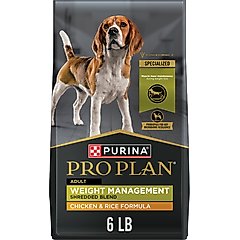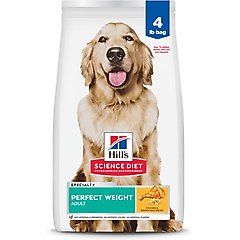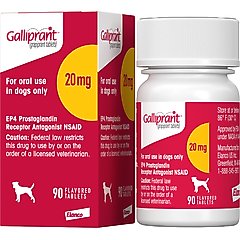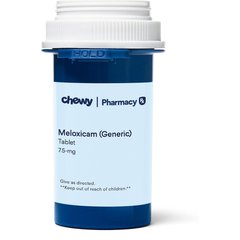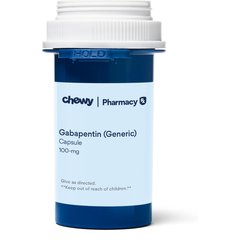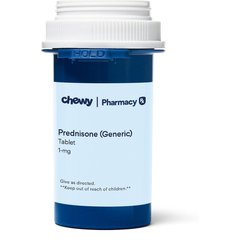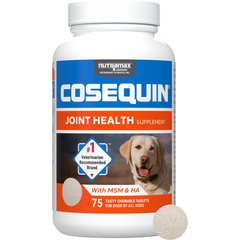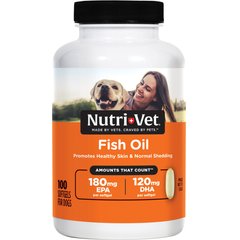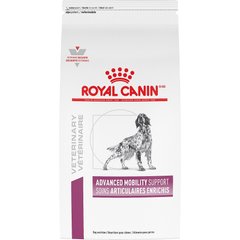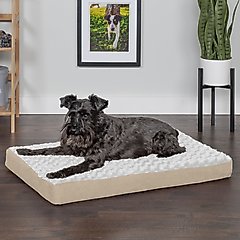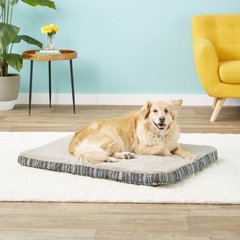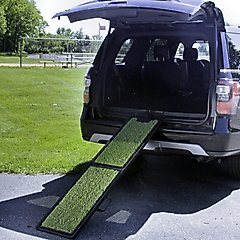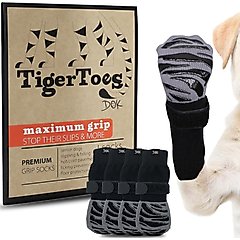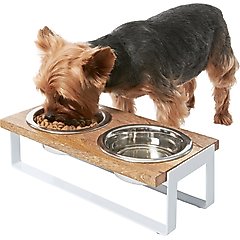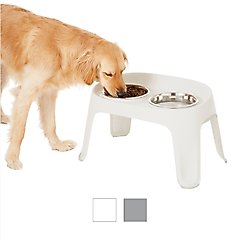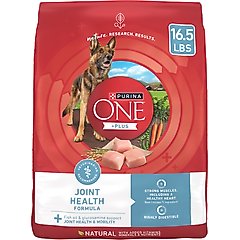What Is Arthritis in Dogs? What Are the Signs?

Photo by Chewy
Does your dog seem slower on walks, hesitate before jumping on the couch, or struggle to get up after resting? Arthritis could be the culprit, especially if your pup has entered their golden years.
Arthritis in dogs is a condition that causes inflammation in one or more joints, leading to discomfort, swelling, and/or stiffness. The most common form of arthritis in dogs is osteoarthritis, which causes the breakdown of cartilage, the smooth tissue that cushions the ends of bones. This breakdown leads to pain, stiffness, and loss of joint function.
We spoke to two veterinarians to learn all about dogs and arthritis, including the signs and causes, and how to help your arthritic pup continue living an active, happy life.
What Are the Signs of Arthritis in Dogs?
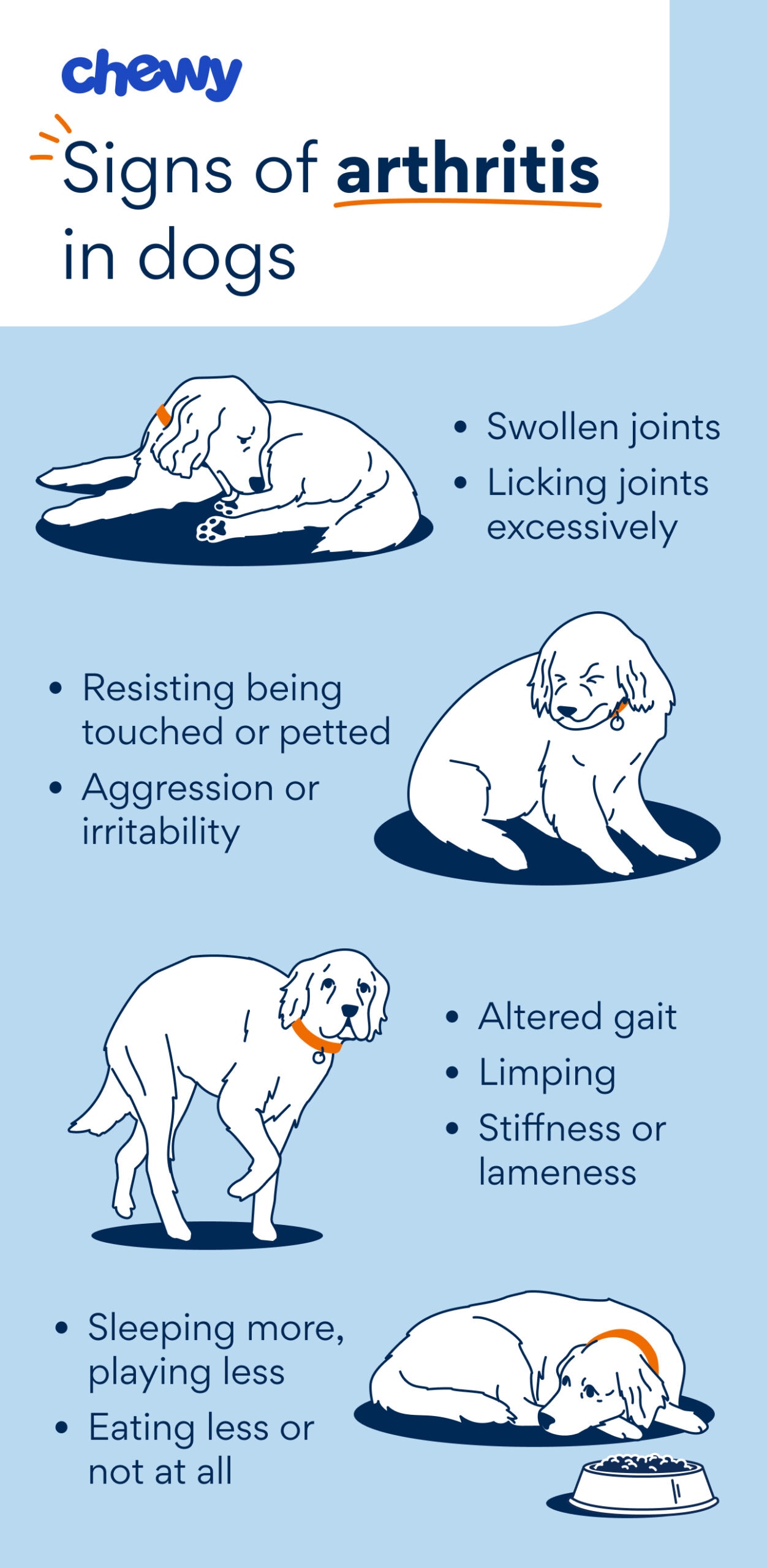
Photo by Chewy
Arthritis can occur in dogs of any age, but it’s more common in older dogs. It often develops gradually, making it easy to overlook the early signs.
Keep an eye out for these common indicators that your pup might be dealing with this condition:
- Difficulty getting up or down stairs
- Avoiding activities such as running or jumping
- Altered gait
- Stiffness or lameness (e.g., difficulty moving from sitting to standing)
- Limping
- Sleeping more
- Playing less
- Eating less or not at all
- Resisting being touched or petted
- Aggression or irritability
- Swelling or tenderness in joints
- Licking joints excessively
What Causes Arthritis in Dogs?
Arthritis in dogs often develops due to a combination of factors that lead to joint inflammation and cartilage degradation, says Kelly Hood, DVM, an associate veterinarian at Highlands Veterinary Center in Chesapeake, Virginia.
The most common contributing causes include:
- Joint wear and tear: Over time, the natural aging process can lead to cartilage breakdown, especially in active or older dogs.
- Genetics: Some breeds, such as Labrador Retrievers, German Shepherds, and Golden Retrievers, are more prone to developing arthritis due to hereditary joint conditions.
- Previous injuries: Joint injuries, such as ligament tears or fractures, can increase the risk of arthritis later in life, even after healing.
- Hip or elbow dysplasia: Hip or elbow dysplasia can lead to joint instability, causing early onset arthritis.
- Excess weight: Carrying extra weight puts added stress on joints, accelerating cartilage breakdown and inflammation.
- Abnormal joint development: Poorly formed joints, often due to rapid growth in puppies, can lead to uneven wear and arthritis over time.
- Lifestyle factors: Lack of exercise can lead to weak muscles and poor joint support, while overly intense activity can strain joints and contribute to arthritis.
- Autoimmune disease: Though rare in dogs, immune-mediated arthritis can occur.
- Infection: In rare cases, bacterial or fungal infections in the joints can lead to septic arthritis.
Larger dogs are more prone to developing arthritis, says Dr. Hood, adding that “they can often develop it at a younger age than smaller breeds due to the increased stress their size puts on their joints.”
How Do Vets Treat Arthritis in Dogs?
If you notice symptoms of arthritis in your dog, schedule an appointment with your veterinarian.
The vet will ask about symptoms; perform a physical exam to check for joint movement, pain, and swelling; and typically take X-rays to assess joint damage.
Dog arthritis treatment focuses on reducing pain, improving mobility, and slowing joint damage. Plans are customized for each dog and might include the following components.
Weight Management
Keeping your dog at a healthy weight is the most critical aspect of treatment, says Marc Smith, DVM, MS, owner of Natchez Trace Veterinary Services in Nashville, Tennessee.
“Carrying excess weight strains the joints, accelerates wear and tear, and increases overall body inflammation,” he explains.
A balanced diet and regular exercise are key to keeping your pup at a healthy weight. Ensure you measure your dog’s food with a dog food scoop or use an automatic dog feeder that measures out meals so portions stay consistent.
Recommended Products
Your vet may also recommend a weight management dog food if your dog needs additional help to lose weight.
Recommended Products
Arthritis Medicine for Dogs
Veterinarians often prescribe non-steroidal anti-inflammatory drugs (NSAIDs), such as Galliprant, carprofen, or meloxicam, to reduce inflammation and ease arthritis-related pain.
Recommended Products
In addition to NSAIDs, your vet might recommend other medications to manage your dog’s symptoms, including:
- Nerve pain relievers, such as gabapentin, to reduce chronic pain
Recommended Product
Recommended Product
- Librela injections, designed to treat osteoarthritis pain in dogs
In some cases, steroids like prednisone might be prescribed for short- or long-term use to control inflammation and pain. However, steroids should never be given alongside NSAIDs, as the combination can lead to serious side effects like stomach ulcers.
Recommended Product
Joint Supplements for Dogs
Dog hip and joint supplements can be taken alongside medications to reduce pain and inflammation. Ask your vet before giving any new supplements to your dog.
Supplements Dr. Smith commonly recommends include:
- Glucosamine: Dr. Smith advises choosing a glucosamine supplement that includes chondroitin and MSM, such as Nutramax Cosequin or Nutramax Dasuquin, as these ingredients work synergistically to promote joint health.
Recommended Products
- Fish oil: Fish oil supplements for dogs, such as Nutri-Vet Fish Oil, have been shown in studies to reduce inflammation.
Recommended Products
Dog Food for Arthritis
Veterinarians often recommend therapeutic dog food for dogs with arthritis, such as:
Recommended Product
Recommended Product
Recommended Product
These foods contain therapeutic levels of supplements known to contribute to improving arthritis symptoms in dogs. They all require vet authorization.
Physical Therapy
Physical therapy uses targeted exercises and treatments to manage pain, promote healing, and improve mobility in dogs with arthritis.
One common form is hydrotherapy, where dogs exercise in water to relieve joint pressure while rebuilding muscle strength and increasing mobility.
Alternative Therapies
Some pet parents might explore alternative therapies, such as acupuncture, laser therapy, shockwave therapy, and electrical stimulation.
These treatments can be used in combination with traditional approaches, potentially providing additional relief.
How Can I Help My Dog With Arthritis at Home?
Small changes in your dog’s home environment can make a big difference in their comfort and mobility. Here are some practical ways to support your arthritic pup.
Provide an Orthopedic Dog Bed
“A supportive, memory foam bed relieves pressure on sore joints and promotes restful sleep,” Dr. Smith says.
A couple of pet parent favorite orthopedic dog beds include the FurHaven NAP Memory Foam Dog Bed and the Petmate Antimicrobial Deluxe Orthopedic Dog Bed.
Recommended Products
Set Up Ramps for Easy Access
“Minimize stress on joints by using ramps for beds, couches, and vehicles instead of allowing your dog to jump,” Dr. Smith advises.
Choose dog ramps with a gentle incline and a non-slip surface for safety, such as the PetSafe CozyUp Wooden Ramp or the Gen7Pets Natural-Step Foldable Dog Car Ramp.
Recommended Products
Use Non-slip Rugs or Socks
Because hardwood and tile can be slippery, Dr. Smith suggests placing non-slip rugs or mats in high-traffic areas and near your dog’s favorite resting spots to prevent slipping and ease movement around the house.
You might also consider arthritis socks for dogs, such as DOK TigerToes Anti-Slip Senior Dog Socks, which have non-slip soles that provide extra traction when walking on smooth surfaces.
Recommended Product
Toenail grips can also be beneficial for arthritic dogs on slippery surfaces.
Use Elevated Food and Water Bowls
“Elevating bowls reduces strain on the neck and front legs, making mealtimes more comfortable,” Dr. Smith says.
A couple of elevated dog bowl options to consider include the Frisco Wooden Bars Double Bowl Diner (for small dogs) and the Frisco Elevated Dog Diner (for large dogs).
Recommended Products
Keep Your Home Warm
“Cold weather can worsen arthritis symptoms,” Dr. Smith says. He suggests keeping your home warm and, if needed, using a pet-safe heated pet pad, such as the K&H Pet Products Heated Dog Bed.
Recommended Product
Consider a Dog-Lift Harness
A dog-lift harness, such as the WALKABOUT Walkabelly Support Sling Dog Harness, can provide extra support when your pup needs help climbing stairs, getting in and out of the car, or rising from a resting position.
Recommended Product
How Can I Prevent Arthritis in My Dog?
Genetics plays a role in dog arthritis, but so does preventive care.
There are several steps you can take to lower your pup’s risk of developing arthritis or reduce the severity of the condition, including:
- Keep your dog at a healthy weight. “The single most important step pet parents can take to reduce the risk of dog arthritis is to maintain your dog at a healthy weight,” Dr. Smith says. To maintain a healthy weight, avoid overfeeding and limit treats, including human food, to no more than 10% of your dog’s daily diet.
- Feed your puppy an appropriate diet. Feed a balanced puppy food formulated for steady growth, such as Hill’s Science Diet Puppy. Rapid growth can strain developing joints, increasing the risk of orthopedic issues and arthritis.
Recommended Product
- Provide regular, low-impact exercise. “Consistent, low-impact exercise is essential for keeping joints mobile and muscles strong,” Dr. Smith says. “Activities like daily walks, swimming, and controlled play help maintain flexibility and mobility without placing excessive stress on the joints.”
- Feed a joint-supportive diet. Feed high-quality dog food with joint-friendly ingredients, such as Purina ONE +Plus Adult Joint Health Formula Dry Dog Food.
Recommended Product
- Protect against injuries. Joint injuries can increase the risk of arthritis later in life. Dr. Smith suggests avoiding high-impact activities such as repetitive jumping or running on hard surfaces, especially in large breeds.
- Start joint supplements early. Introducing joint-support supplements early, especially for large or active dogs, can help protect cartilage and support long-term joint health.
- Schedule regular vet checkups. Routine veterinary checkups can help detect signs of joint issues, allowing for early intervention. Your vet can also recommend personalized preventive care strategies based on your dog’s age, breed, and lifestyle.
FAQs About Dogs and Arthritis
Q: How long will a dog with arthritis live?
A: With proper management, dogs with arthritis can enjoy a long, happy life. While the condition itself isn’t life-threatening, untreated pain and mobility issues can significantly impact the dog’s quality of life. In severe cases where treatment is not effective, euthanasia may be considered.
Q: What are the four stages of arthritis in dogs?
A: Osteoarthritis in dogs progresses through four stages: early, mild, moderate, and severe. Your veterinarian can determine your dog’s stage based on symptoms and the evaluation of their joints.
Q: How can you tell if a dog has arthritis?
A: Common signs of arthritis in dogs include stiffness, limping, reluctance to jump or climb stairs, difficulty rising after rest, and decreased activity.
Some dogs might also show signs of pain, such as whimpering, licking at joints, or changes in behavior.
If you notice any of these symptoms, take your dog to your vet for an evaluation.
Attributions
This content was medically reviewed by Tara Hansen, DVM, Chewy veterinarian.


